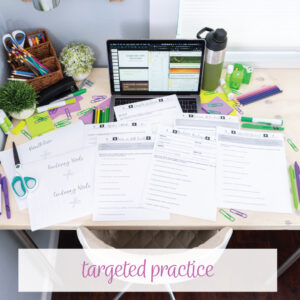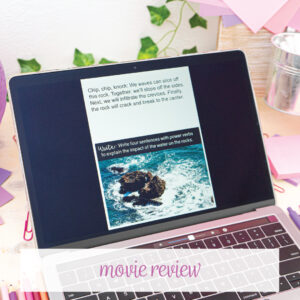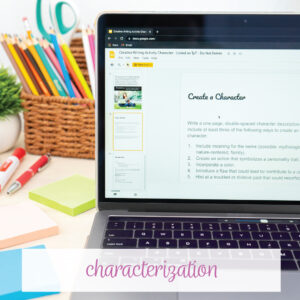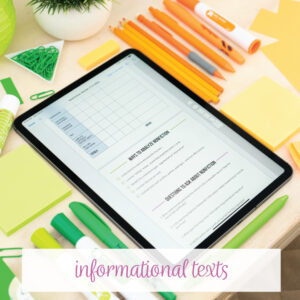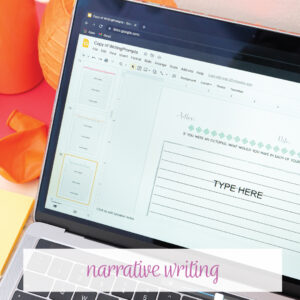Looking for digital writing activities for distance learning? Maybe creative writing distance learning activities? You do NOT need to overwhelm yourself or students. With these ten distance learning writing activities, you can meet standards and fairly assess students.
I have found providing student choice, chunking material, and allowing for creativity make the perfect recipe for writing, distance learning or not. When I experimented with digital writing activities, I quickly learned those three goals would help my students.
We still need to meet standards while accommodating for students learning at home. I’m sensitive to students who might not have an adult who can help or have a quiet place to work. When I assign writing activities, I need flexibility.
I hope that with these ten digital writing activities for distance learning, you can find some inspiration or materials with your online endeavors. We teachers can do anything; fun distance learning included.
1. Picture + Caption
Ask students to find an older item and give it a caption. Older dolls or toy trucks? Parents’ tape collections? Students maneuver them in a goofy situation and write about them. (Think about placing dolls at the kitchen table.) Fun distance learning can happen with odd objects.
A fun alternative to this activity is for students to take a picture of unique situation. (If they do not have a camera, they can also draw a picture.) What unique situation? Students have surprised me with fun approaches!
-
Adding googly eyes to random objects like milk jugs and turning the object into a character. (I’ve also seen arms and legs made from construction paper.)
-
Creating a society out of random objects like rocks or potatoes.
-
Practicing dialogue between dolls or LEGO figures.
-
Finding parts of nature that depend on each other. For example, trees that have grown into sidewalks.
Honestly, every time I assign my simple “picture + caption” activity, students blow me away with their designs. The pictures are funny, and the captions take on all sorts of meaning. Sometimes students write an advertisement for a potato family or outline a conflict between architecture and nature. I typically give a brief assignment like, write a story about your picture. These caption activities are the perfect creative writing distance learning.
Get students brainstorming and thinking away from normal writing topics. Students run with the idea, and we have a compilation of memorable pictures.
2. Interview
Assign an interview that can be completed via email or in-person. Remember that some students might not have someone at home to interview. I work with students (sometimes I am interviewed), but often, students interview each other. During distance learning, writing specifics (like interviewees) require flexibility.
One important piece for conducting interviews is having strong questions. Work with students to create open-ended questions instead of questions that require one simple answer. The composition and thought process of creating questions is a writing assignment itself.
You can arrange this assignment however your students need, but interviews allow for multiple writing opportunities. Students should write open-ended questions, the answers for follow-up questions, and the final profile piece. For a mentor piece, I use 13, right now. If students are writing through the COVID-19 event, they are creating a historical document—a future primary source.
3. Journal
A journal can be made from anything: an old notebook, scrap paper, a blank digital document. Since COVID-19 is a historical event, ask students to create a primary source that records their feelings and ideas. If you don’t want to grade all of their personal thoughts, ask them to submit what they are comfortable. With distance learning writing, you don’t need to grade every piece of writing.
Some students balk at sharing a journal with anyone else, and I understand that. When students share their reluctance, I provide an alternative. Often, I ask students to write a journal from a character’s perspective. (I’ve had very insightful journals from Shakespearean characters.) I’ve also broken the process down more into a emails or text exchanges between characters. If students are journaling, the point of view seems secondary. When I encourage creativity with students, I find fun distance learning results!
4. Targeted Practice
Differentiation is easier (for me!) with distance learning. Digital writing activities allow teachers to target what each student needs by assigning different practice for different students. . . and no one know! I simply push material to students based on what they need to practice. Since I am not with students, I am sure to chunk the material.
For instance, I might send seven students a lesson on semicolon use, six students a lesson on comma splices, five students a lesson on apostrophes, and nine students a lesson on subject-verb agreement. If I were teaching creative writing, I might assign targeted writing practice on characterization, setting, dialogue, whatever! Writing distance learning style is forcing me to be creative with differentiation!
As I grade a writing assignment, I keep a running list of where students can improve. I base the targeted practice off their prior work. And! Targeted practice allows for a great grammar to writing connection. Sure, creative writing is the perfect time to break grammar “rules” (does a character speak in fragments? with double negatives?), but part of the fun of having that foundation of grammar is knowing how and when to break grammar rules for effect.
5. Movie Review
Years ago I taught a journalism unit. We closed with a movie review on a movie that we watched together as a class. (It was tons of fun.) Another time, we watched a movie with an athletic event and wrote a sports article about the final game. (Full disclosure: I did not develop that lesson plan, but it was hilarious.) Students applied domain-specific vocabulary from an ELA class while writing a new form. If you want to provide student choice or engage students without a movie, ask them to write a review over a book, YouTube Channel, or video game. Distance learning writing can take advantage of what students already do at home.
Teach students to create their own headings and subheadings in their documents. Give students the chance to create a blog post. You could even assemble all of the reviews on a free hosting page. Organizing different documents and using different forms well is a lifelong skill. Plus, you can implement pacing, imagery, or dialogue into a movie review.
If you wanted to be specific, you could assign a specific genre or artist. For instance, students may be unaware of Alfred Hitchcock, but his skills still influence movie development. Ask students to watch one of his movies and conduct research on him or his influence on other movie directors. Students might be ignorant of documentaries, but students should know how to fact-check them.
Many product companies are broadcasting their plays for free. Actors are reading books. Ask students to choose one video and write a review.
6. Characterization
Memorable characters are not simple or easy to write. One activity I complete with students is to write a police report, text, email, or journal entry as a character that I’m creating. I add pictures to start my inspiration, and then I write about my character’s feelings and ideas in the chosen format.
I might even summarize the character’s day: morning routine, lunch choices, type of pajamas. Then I can discuss with students the type of character who has matching pajamas, robe, and slippers versus a character who wears an old t-shirt to bed. Finally, we write about our characters without including every little detail from the journal. Compiling all of that information from a class also creates a collaborative writing process and incredibly creative characters.
Building characters is a collaborative process, making it perfect for digital discussions. After students create the police report, text, email, or journal, compile them and ask for collective feedback. What sort of character is built? Does a character need fleshed out in a certain area? Once students see that adding on to characters is not a critique of their original development, you’ve made a huge gain in creating writers.
7. Setting
Another digital activity that lends itself to collaboration between the teacher and student is building a setting:
In 1942 in a small town in New York. . .
I joke, but building a setting naturally is tough. I use pictures to inspire and to brainstorm. When students see the intricacies and details a certain setting has, they can imagine what the character sees and what a character would notice. They will also understand how the setting influences other parts of the story. Digital writing activities are the perfect time for experimentation: Should certain action take place in a dark setting? Would the character behave differently at certain locations? If we, the writers, know all of the details of the setting, do we still need to include all of those details in the final draft?
Then, after we have ideas about our setting, we naturally weave the setting into the story.
8. Graphic Organizers
Part of working with young writers is helping them find what works for them. I share my process which involves TONS of list making. Even after I have a rough draft, I print out my paper and create more lists of where to focus. I explain to students that I’ve never seen anyone else with that process, and that is fine! Part of writing is experimenting with what moves you forward as a writer.
For example, personalize with graphic organizers. If you have a PDF you like, you can add it to your Google Drive. (If you want to export the PDF as .JPGs, you can use smallpdf.com to create those images.) Then insert each image onto a Google Slide. Students can insert text boxes and write on the graphic organizer.
When I use graphic organizers, I take into account that some students feel inspired to write in a serious manner, and other students appreciate a bit of humor. I provide several tools because I don’t know exactly what will appeal to every student.
9. Response to Informational Texts
Choose a timely article and have students write a response. Using an informational text can help you meet multiple standards. (You can use the form below to receive an editable writing activity for an informational text.) You can provide news, sports, nature, and fashion sites and allow students to choose an article. If that sounds overwhelming, a site like CommonLit provides choice with narrowed options.
Dependent on your students’ needs and ages, you could find two articles about the same topic. Ask students to evaluate the author’s tone and message in each article.
10. Narrative Writing
My students keep a notebook when they are in a physical classroom. For online learning, I make a copy of digital writing prompts for each student, and I made the concepts overwhelmingly goofy. Why? When students have low-stress opportunities to write, their confidence increases. Then, when students write longer papers, they get right back on the bicycle. Students succeeded at working through a tough concept and can begin the longer paper.
Students date their work, and I can track their growth. As we continue, I’ll add certain directions to expand their writing experience: insert dialogue, work on a conflict, work on the setting, or add a piece of comedy. Since the experiences are smaller, students can taste what those writing elements can do for their writing as a whole.
Digital notebook writing and communicating back and forth with my students has been a perfect way to build relationships when you are in a distance learning environment.
Overall, you can encourage student choice with any of these distance learning writing activities or with variations of them. For instance, provide two graphic organizers, two grammar to writing connections, or two formats for a book or movie review. I have found that giving students too many choices overwhelms them but when I provide two choices, they are happy to pick what best works for them. You will find your groove with digital writing activities!
When I assign open-ended projects like “create a journal,” I am ready for students to surprise me. Sometimes a journal is not what I expect, but if a student is writing, I’m fine what that!
Finally, use digital writing as an opportunity to collaborate as a class. Share a Google Slides presentation and ask students to contribute. Piece together a character or setting. Jump in with students and model writing, brainstorming, and creativity for them.
How are you managing digital writing activities with secondary students? What have you found to be successful?
Writing, distance learning or not, can be creative and fun. Provide students with a bit of choice and encourage their ideas for distance learning writing assignments.





